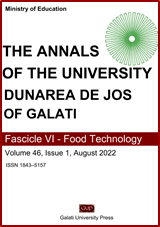Tunisian Opuntia ficus-indica fruit peels: biochemical and microbiological characterization and possible applications
Abstract
In Tunisia, the number of prickly pear seed oil companies is currently increasing. However, a large amount of prickly pear fruit by-products is discarded. Proper utilization of these by-products, in particular fruit peels, could lead to the obtaining of a new important source of nutraceutical compounds. This investigation was aimed at conducting a phytochemical screening and assessing the antibacterial properties of prickly pear peels cultivar ‘orange’. These samples were analyzed fresh and oven-dried at 45 °C to develop concepts for applications in the food industry as potential sources of fibers and antimicrobial “green” additives. The proximate compositions of both prickly pear peels were determined along with total phenolic compounds, carotenoids, and antioxidant activity. Free phenolic compounds were determined using liquid chromatography coupled with mass spectrometry. Furthermore, the antibacterial effectiveness of the prickly pear peel extracts was tested against selected foodborne pathogens. The highest concentrations of dietary fiber (22.7 g/100 g d.m.) and carotenoids 10.90 mg/100 g d.m. were observed in oven-dried prickly pear peels, which also showed the highest inhibition of the DPPH radicals. The antibacterial activities showed a relevant growth inhibition against Bacillus cereus and a partial inhibition against Staphylococcus aureus. Prickly pear peel is a neglected nutritional and antibacterial source that should be widely valued as food additive.


